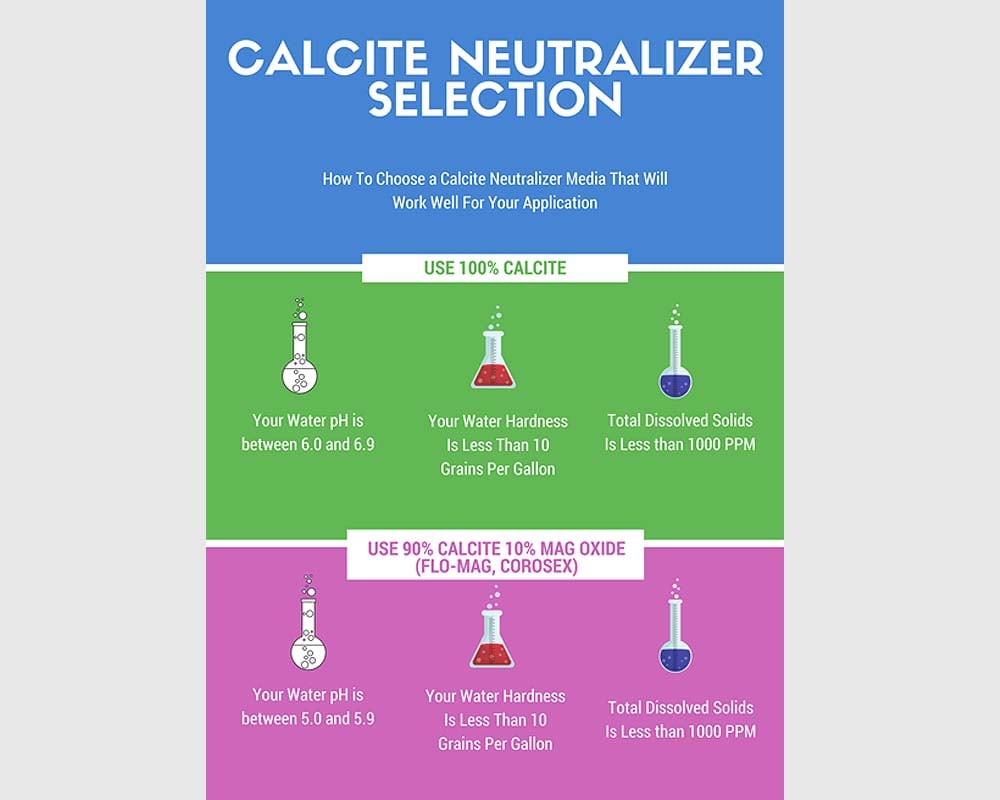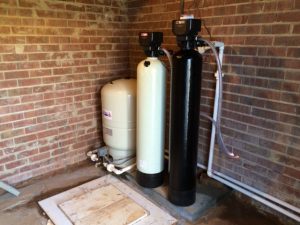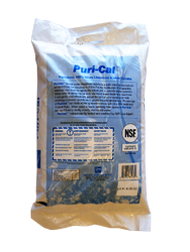Choosing a Calcite Water Neutralizer for Acid Well Water


A Calcite Water Neutralizer Can Treat Acid Water from pH 5.0 to 6.9


If you have acidic well water, a calcite water neutralizer is one of the most effective and natural water treatment options available. It’s designed to raise the pH of your well water safely and gently, helping protect your plumbing system, appliances, and water quality over time.
When Should You Use a Calcite Water Neutralizer?


A calcite water neutralizer is most effective when your well water has a pH between 6.0 and 6.9. In these conditions, calcite—a natural form of calcium carbonate—dissolves slowly in water and increases the pH to neutral levels.
Calcite is safe, NSF-certified, and made from high-purity limestone. Brands like Puri-Cal, which is mined in Washington state, are popular because of their consistent quality and performance. When added to a neutralizer tank, calcite dissolves gradually and doesn’t introduce harmful chemicals into your water supply.
What If Your pH Is Lower Than 6.0?
If your pH is below 6.0, consider blending your calcite with magnesium oxide—also known as Mag Oxide. This boosts the pH more quickly. Common product names include Corosex and Flomag. An 80% calcite and 20% magnesium oxide mixture is typically effective.
Be careful: too much magnesium oxide can overcorrect the pH, pushing it above recommended levels and potentially leading to issues like scale buildup or an overly alkaline taste. This is why many homeowners start with a smaller percentage and increase gradually if needed.
When to Consider Soda Ash
If your water’s pH is below 5.0, a calcite water neutralizer might not be sufficient. In these cases, a chemical feed pump is recommended to inject a soda ash solution. This method is more aggressive and better suited for extremely acidic water. Soda ash (sodium carbonate) is effective and commonly used in residential systems.
Sodium hydroxide is another alternative to neutralize acidic water efficiently in commercial and industrial water treatment applications. Always follow manufacturer guidelines or consult a water specialist to select the right method.
The Impact of Hard Water on Calcite Performance
Hard water with high levels of calcium and magnesium can interfere with calcite's ability to dissolve. If your water hardness is over 10 grains per gallon (about 171 mg/L), the calcite media may struggle to function efficiently. In this case, soda ash injection may work better.
That said, most acidic water is naturally soft, so this is typically only an issue in areas with unusually high calcium hardness.
Choosing the Right System for Your Home
Not all systems are the same. If you’re treating a whole house supply, make sure the acid neutralizer tank is sized correctly and installed at the point of entry to your plumbing. This ensures every tap in your home delivers treated water that won’t corrode copper pipes or stain your fixtures.
Look for systems that are easy to maintain and allow you to refill the calcite media as needed. Regular maintenance will help your water neutralizer perform optimally over time.
Is Your Water Safe to Drink?
While acidic water doesn’t typically pose a direct health threat, the health problems come from what it pulls into your water—heavy metals and corrosion byproducts. These can lead to long-term exposure issues. That’s why neutralizing your water isn’t just about protecting your pipes but also your family.
If you’re unsure whether your water needs treatment, have it professionally tested. Water tested by a certified lab can tell you more than just pH—it will also provide levels for copper, lead, sodium, and other potential concerns.
Final Thoughts
A calcite water neutralizer is one of the simplest and most effective ways to treat acidic well water in the 5.0 to 6.9 pH range. Whether you use 100% calcite or blend it with Magnesium Oxide, this natural water treatment option protects your plumbing system, improves water quality, and helps maintain the safety of your drinking water.
If your water is too acidic for calcite alone, soda ash injection is another powerful option to consider.
Need help choosing the right acid-neutralizer tank or whole-house solution? Our team can help guide you toward the best system based on your home’s unique water chemistry.
For more information on pH levels and secondary drinking water standards, visit the EPA’s official guidelines on nuisance chemicals and water quality.
Frequently Asked Questions (FAQs)
1. How do I know if I need a calcite water neutralizer?
If your well water has a low pH—typically between 5.0 and 6.9—a calcite water neutralizer can help bring it to a neutral level. Signs of acidic water include blue-green stains, corroded copper pipes, and a metallic taste. A professional water test can confirm your pH and other water quality parameters.
2. Can a calcite water neutralizer remove hard water?
No. Calcite neutralizers are designed to correct pH, not remove minerals that cause hard water. In fact, calcite can slightly increase calcium hardness. If your water is hard, you may need a water softener in addition to a neutralizer.
3. What is the best pH range for using 100% calcite?
100% calcite works best when the water pH is between 6.0 and 6.9. If it's lower than 6.0, it's recommended to mix in magnesium oxide to increase the pH more effectively.
4. How often do I need to add calcite to my system?
It depends on your water usage and pH levels, but typically, it happens every 3 to 6 months. You’ll need to monitor the media level in your neutralizer tank and add more calcite when it drops below the halfway point.
5. Is soda ash better than calcite for acidic water?
Soda ash is better for very acidic water with a pH below 5.0, especially when calcite alone won’t be effective. It’s typically injected with a chemical feed pump and works well in residential and commercial applications.
Recent Posts
U.S. Water Problems by Region: Common Contaminants & Solutions
Curious about U.S. water problems by region? Water quality isn’t just a national issue—it’s a…
Wildfire Water Contamination: How to Ensure Safe Water After a Fire
Wildfire Water Contamination: What You Need to Know After the Fires Wildfire water contamination poses…
Clean Water For Pickles: The Secret Ingredient
Using clean water for pickles is not just a best practice—it’s crucial for achieving great…
How to Test and Remove Manganese in Well Water: A Complete Guide
If you rely on a well for your home’s water supply, you might have encountered…
Effects of Chlorine and Hard Water on Skin: Top Skin Problems and Solutions
Effects of Chlorine and Hard Water on Skin: Top Skin Problems and Solutions Have you…
How Whole House Water Filters Keep Your Family Safe: A Mom’s Guide
When creating a safe and healthy environment at home, clean water is essential—especially for moms…

